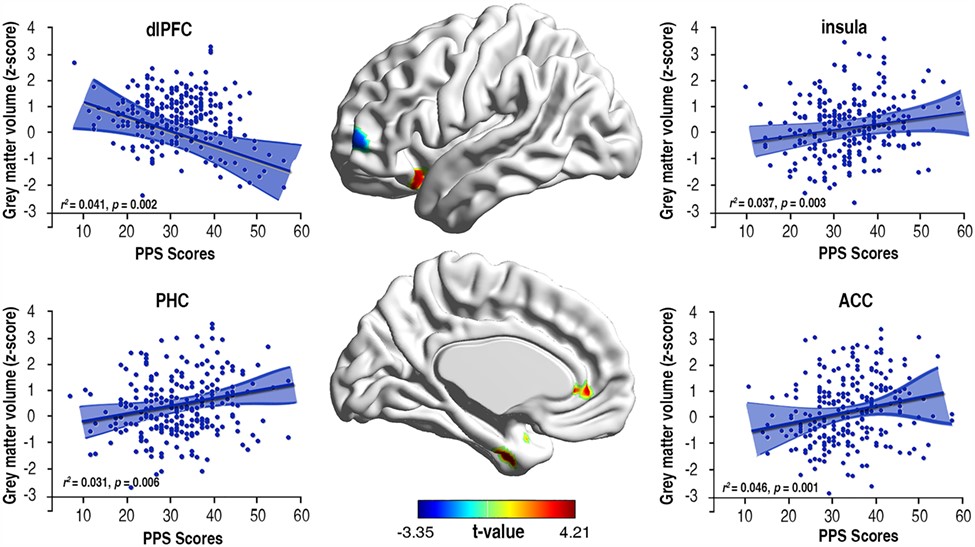Procrastination is often misunderstood as merely poor time management or laziness, but research increasingly shows it’s primarily an issue of emotional regulation, not time management1. Procrastination occurs when our drive to delay becomes irrationally stronger than our drive to act. This happens when self-control and motivation are weakened by issues like exhaustion and are opposed by negative emotions such as fear and anxiety.
Neuroscience research has identified specific brain regions involved in procrastination. A study published in Nature Communications found that the anterior cingulate cortex is where the decision to procrastinate is made, as it performs cost-benefit calculations by integrating efforts and rewards associated with each option. Additionally, brain imaging studies have shown that procrastination is linked to decreased gray matter volume in the dorsolateral prefrontal cortex (a region associated with self-control) and increased volume in areas related to emotion and episodic thinking.

Brain maps and scatter plots for the correlation between the GMVs (z-scores) of significant clusters and the procrastination (PPS scores) in the Sample 1. The sagittal brain maps with both medial and lateral sides located at left hemisphere were mapped to the MNI152 space of the glass brain template. The shadow areas indicated the corresponding 95% CI for the estimated model. Source: Cerem Cortex, Volume 30, Issue 5, May 2020, Pages 2834–2853, https://doi.org/10.1093/cercor/bhz278
This shows, that while still useful, the typical recommendations2 are focused more on the symptoms, than root-cause.
Handling Negative Emotions
As we have established, the procrastination is primarily an emotional regulation problem. One of the most impactful technique is just “sitting through” it. Not letting the emotion push us towards easier dopamine generating escape behavior. This also allow us to observe the emotion, get more familiar with it. This can be “simple” as stopping3 for couple minutes and breathe.
Research 4 showed that 3-minute mindfulness exercise significantly improved intention to work on the task at hand. Also, they have showed that consistency of the exercise is important.
Cognitive Restructuring
Our perception of the task as had has direct impact on the level of procrastination. We need to find an angle which makes the task less intimidating and allows for immediate start. Instead of shaming ourselves for starting too late (and not starting at all), allow for better start now than ever. Even small progress right now is better than none. And staying focused on what we can do right now, and do the progress.
If this is not enough, we can re-focus on the task’s benefits, moving attention from immediate discomfort to the long-term rewards. Or maybe a small challenge – what can I do in 2/5/10 minutes with this task? Very similar is moving from outcome to progress – “I will write for 20 minutes”, instead of “I will finish the chapter”.
Breaking the Shame Cycle through Self-Compassion
Procrastination is frequently accompanied with self-blame5. While this is a completely normal reaction, it is counterproductive. As shame and gilt makes the emotions even more negative and hard to cope with. Thus we are even more incentivized to remove ourselves from these negative emotions through quick dopamine release activity. Therefore, self-blame creates a vicious cycle, where shame leads to more procrastination6.
Instead of beating yourself up, start talking to yourself as to your friend. Treat yourself with the same kindness as you treat your loved ones. It is about recognizing, that this is completely normal human behavior (everyone struggles with procrastination sometimes). Self-compassion is about building inner safe harbor (emotional and psychological safety) to allow taking the immediate action towards progress.
-
https://www.bbc.com/worklife/article/20200121-why-procrastination-is-about-managing-emotions-not-time ↩︎
-
As said, it is still useful to break a complex task into smaller ones. Or scheduling demanding tasks during peak energy hours. ↩︎
-
If you don’t want to just sit, one sprinkle techniques like labeling (simply naming the feeling (“I’m experiencing anxiety”) reduces its intensity), body scanning (look where you feel the resistance physically and breathe into those areas) or controlled breathing (inhale for 4 seconds, hold for 4, exhale for 6) to activate the parasympathetic nervous system. ↩︎
-
Schutte, N.S., del Pozo de Bolger, A. Greater Mindfulness is Linked to Less Procrastination. Int J Appl Posit Psychol 5, 1–12 (2020). https://doi.org/10.1007/s41042-019-00025-4 ↩︎
-
You know, those “I can’t get things done.”, “What’s wrong with me?”, “I’m useless”. ↩︎
-
Fuschia M. Sirois , Self and Identity (2013): Procrastination and Stress: Exploring the Role of Self-compassion, Self and Identity, https://doi.org/10.1080/15298868.2013.763404 ↩︎